I was dreaming of this journey over the past twenty years or so. I can’t recall when and under which circumstances I heard of the Way of St. James for the first time, but I know that it was a long time ago and since then I have mused about going on this trip. When I started working as a free-lancer back in 2003 (no formal working hours or leave days for that matter), I started thinking about who I may perhaps go with, primarily in terms of the duration of this journey. So I thought of who may have the time to come with me, as well as who I would actually like to go with. The years have passed and (imagine!) I haven’t become any younger, so I had to take that into consideration as well. Although I’m generally speaking a reasonably healthy person, I still had to consider the fact that I could not foresee in which direction my health was going to go and I thought that it would be better, if I wanted to do this at all, to do it as soon as possible.
Thus, a couple of years ago I started thinking about this seriously, but that year my work engagements, for no reason whatsoever, rather slowed down and I simply gave up the idea. Not entirely though – every now and then I would buy some things having specifically this journey in mind.
But, let me actually clarify what this is all about. The Way of St. James, El Camino de Santiago in Spanish, is one of the most famous, if not THE most famous pilgrimage in the world. The pilgrims follow different routes and cover different distances, but they all lead to the city of Santiago de Compostela in which there is the Cathedral in which the remains of St. James the Great, the apostle, are buried. According to the tradition, St. James the Great was killed in Jerusalem in 44 CE and he was the first apostle to be martyred. Two of his disciples carried the body to the shores of Galicia in Spain and then inland where they buried it. In 812, remains of three bodies were found and it is considered that one of the bodies is that of St. James the Great. Since then, people started to go to Santiago de Compostela as pilgrimage.
Most traditionally, the pilgrimage is done in such a way that one reaches Santiago de Compostela on the Day of St. James (or the day before), when there are large celebrations, but this was not important to me. Moreover, I was absolutely convinced it was some time in September!!! In terms of temperatures, I thought April, May and the beginning of June would be most suitable for me, but I couldn’t make it then on account of my work obligations. And it was precisely because of my work that I decided for the period from 16 June to 31 July, which is in the middle of summer, when it’s usually scorching hot in Spain, but there was nothing I could do about it. Once I was in Spain I realised I had made a total error about the Day of St. James and that the day was celebrated on 25 July, so as it turned out I could make it to Santiago right then. This in turn also suited me, since I would have a little bit more time, around a week, for some other plans I had in mind. I also thought of this as the ultimate proof that I was doing the right thing, since the “higher powers” obviously wanted me to get to Santiago right at the time of the celebrations. By the way, the Serbian Orthodox Church celebrates the Day of St. James the Great on 30 April according to the Julian calendar, which is 13 May according to the Gregorian calendar.
The pilgrimage is done by walking, riding a bicycle or riding donkeys or horses, which is the preferred method by the people who want to do it in the most authentic or traditional manner. Also, very often and obviously traditionally, people do this journey for religious and/or spiritual reasons, but there are also a lot of people, like me, who do it because they feel like it.
Namely, this is a traditional Catholic pilgrimage and by tradition I’m (Serbian) Orthodox Christian although I’m not a practicing believer. On the other hand, at the physical level this was certainly supposed to be a test of myself, facing my own perseverance and stamina, and a unique challenge in my life. In this regard, my only expectation and hope were to sustain; I hoped it would not happen that at some point I would have to give up for any reason whatsoever. From the spiritual side, if I can call it that, since I’m not immune to this either, I first thought this could be my Great Work, but then I gave up thinking about it and eventually in the sphere of the spiritual I did not have any expectations at all. I was supposed to go on this trip and not to deal with any expectations of any kind.
And finally, a few years earlier a friend of mine mentioned that he might want to go on this trip, but he was interested only in walking some 100 km. Also, another friend from high school mentioned that she would like to do “The Way” and asked me if I would be interested in this. I told her I was and it stayed at that. Afterwards I had a few more months to think about this “project” and I finally realised that in fact I wanted to do this journey alone.
Serbia and Belgrade are not well connected with Spain. Except for a low-cost airline company which connects Belgrade and Barcelona only during summer. But, I decided to fly precisely in this way in order to avoid changing planes. The problem for me was the fact that the flight left around 2 am. Of course, I could not sleep before the flight, but miraculously I managed to doze off in the exceptionally uncomfortable seat and I spent some 2 hours like that. Once in Barcelona, following a piece of advice from one of the passengers, I took the underground and with one change of line I transferred to the railway station, which I should have avoided by taking a train directly to the railway station. Sometimes it is wise to listen to other people, sometimes it’s not.
I bought a ticket for the first train to Zaragoza and that was a very comfortable solution, so I even managed to sleep for more than an hour. The rest of the time I looked out of the window and I also had a coffee they were offering on the train. In Zaragoza I took a public bus to transfer to a small hotel in which I had booked a room, but I had to wait until noon to get the key. Still, it meant enough that I could leave my large backpack at the reception, while taking the small one with me as I walked to the Nuestra Señora del Pilar Square where I finally sat down in order to eat something. I enjoyed the respite, but I was still very sleepy. On the other hand, there was no other solution, so I eventually decided to walk to the nearby Basilica Nuestra Señora del Pilar which was right across from the bar in which I enjoyed my rest.
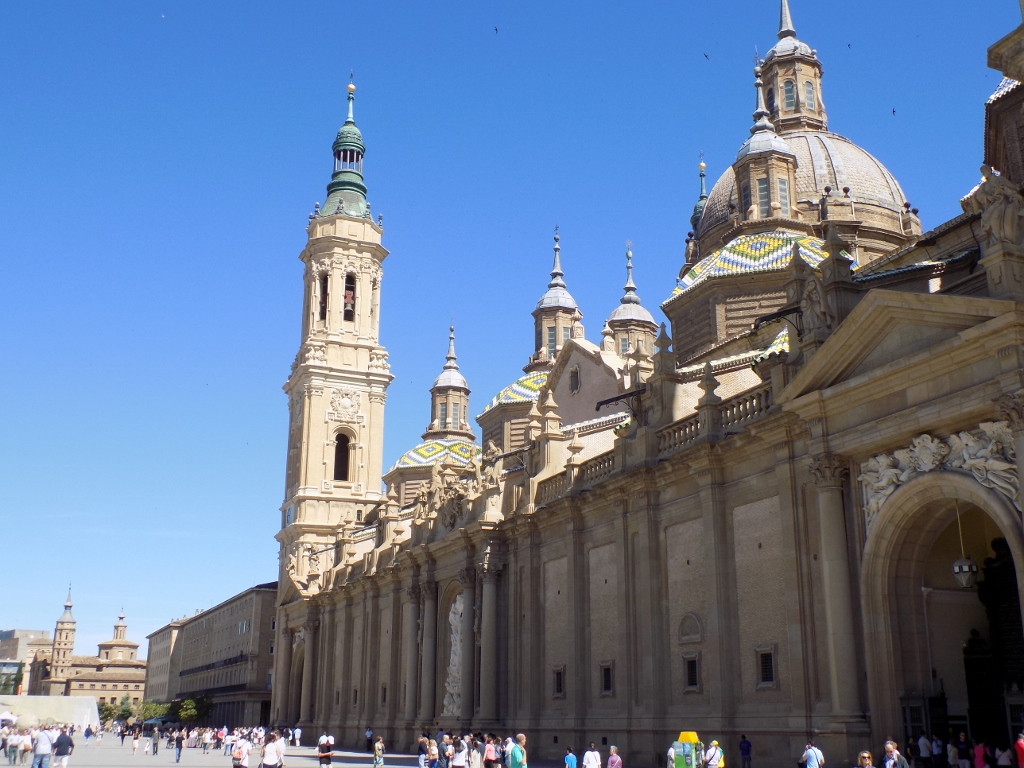 Nuestra Señora del Pilar Basilica
Nuestra Señora del Pilar Basilica
According to the tradition, in 40 CE, Saint James the Great who was on the territory of the present-day Spain at the time (before returning to Jerusalem where the Romans beheaded him) had an apparition of the Virgin precisely in this spot. As a proof of her apparition, the Virgin left a pillar behind her and later a basilica in which there is this pillar preserved was built here and for this reason the church is called the Basilica of Our Lady (the Virgin) of the Pillar, which at the same time is the second cathedral in the city.
After a brief walk around the church, I also went to the Ebro river and then I also remembered that there is a very pretty Stone Bridge in Zaragoza, Puente de Piedra, originally built in the first half of the 15th century, so I went to the bridge as well, taking it to cross to the other side of the river.
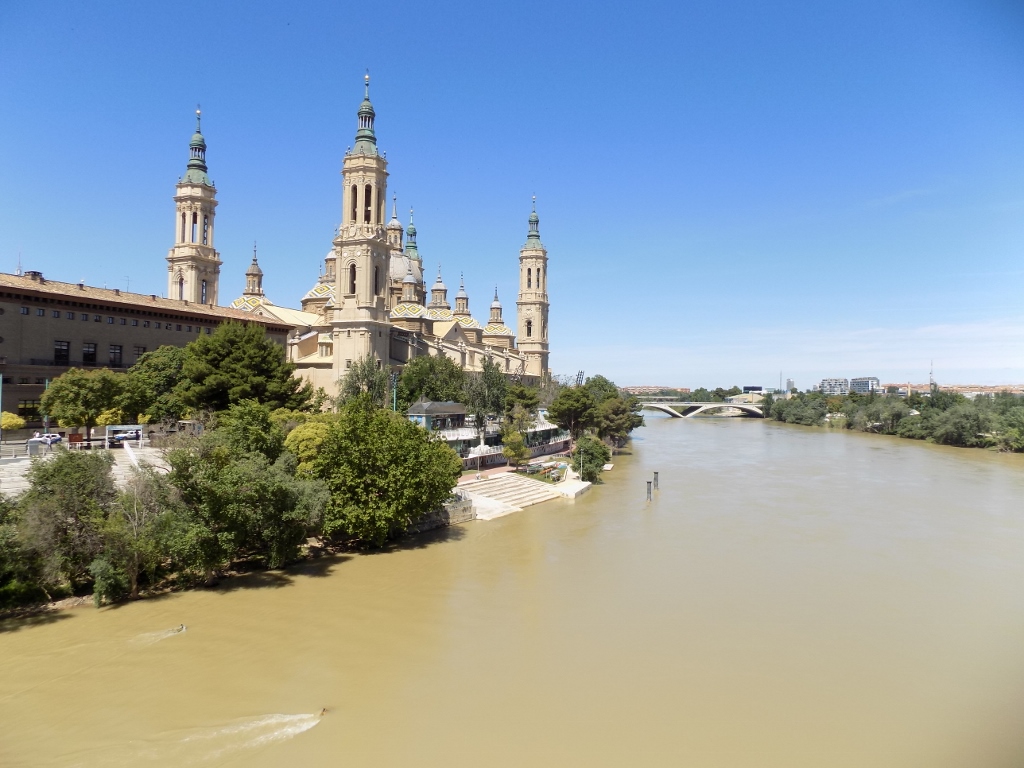 View at the Nuestra Señora del Pilar Basilica and the Ebro river from the Puente de Piedra
View at the Nuestra Señora del Pilar Basilica and the Ebro river from the Puente de Piedra
The day was perfect, sunny, without any clouds, it was warm, but all the time there was a fresh wind, so it was not too hot. Still, at this point, it was already the time for me to head back to the hotel that was ideally located in the centre, so after the formalities about the registration, I took a shower and went to bed. Although I woke up rather drowsy after some three hours, I still thought I had slept enough. So, I got up and headed for Aljafería, stopping along the way to have a strong coffee and wake up a little more.
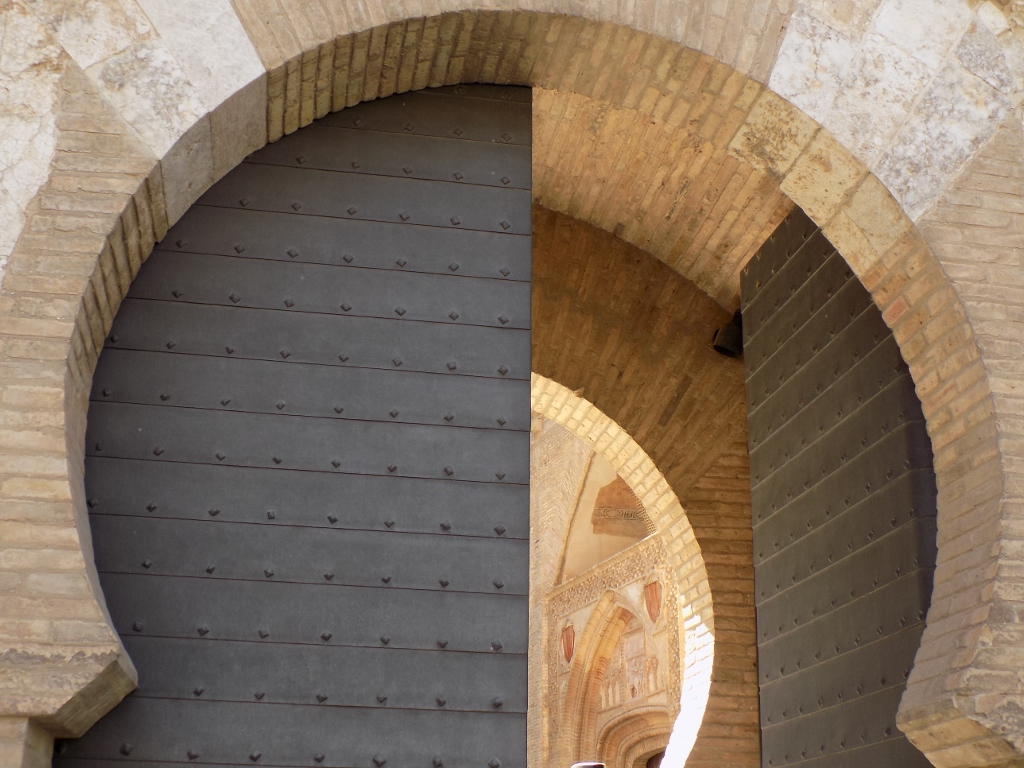 Entrance into Aljafería
Entrance into Aljafería
Aljafería was originally built as a palace of the Moorish rulers. It was later taken over by the Christian rulers and today it is the seat of the Aragonese regional parliament. Still, it is also an important cultural and historic monument, a part of the cultural property that is in the UNESCO’s World Heritage List as the Mudejar Architecture of Aragon and therefore it is open to public. So, I went to visit it this day. Although I got there in time to join a free-of-charge tour in Spanish, I still decided to take an audio-guide in English – I understood the details better in this way, plus I could go at my own pace and this day it was “slowly and at ease.”
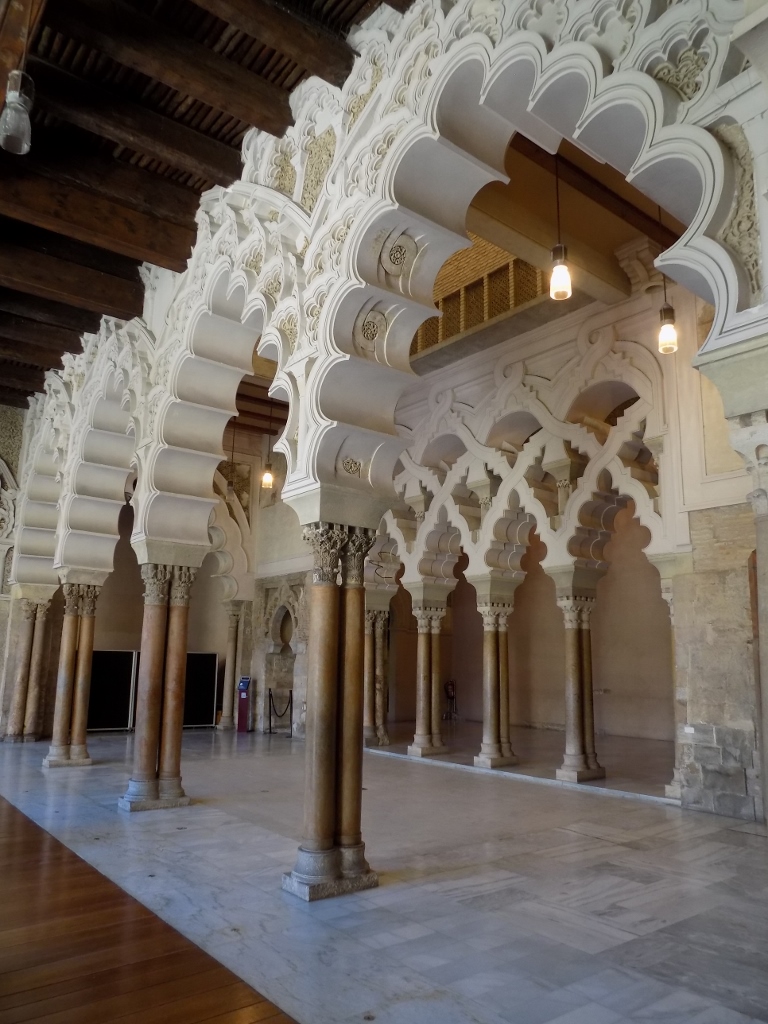 A detail from Aljafería
A detail from Aljafería
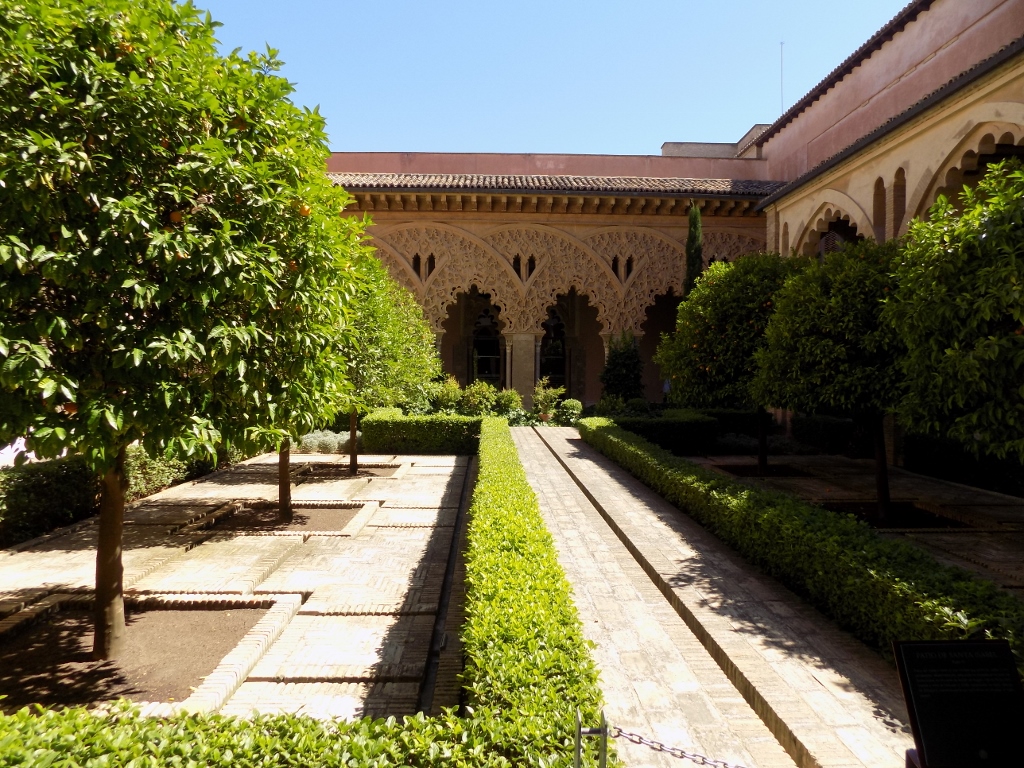 A detail from Aljafería
A detail from Aljafería
These types of buildings are for me incredibly beautiful (years ago I was particularly enchanted by the Córdoba Cathedral) and the mudejar style, as a mixture of Moorish and Christian influences developed after the Christians won back the territories ruled for a while by the Moors, is one of the most harmonious architectural and artistic styles for me, so while standing in a yard of the Moorish part of the Palace I could not stop enjoying the place. Still, at some point I continued following the visiting tour.
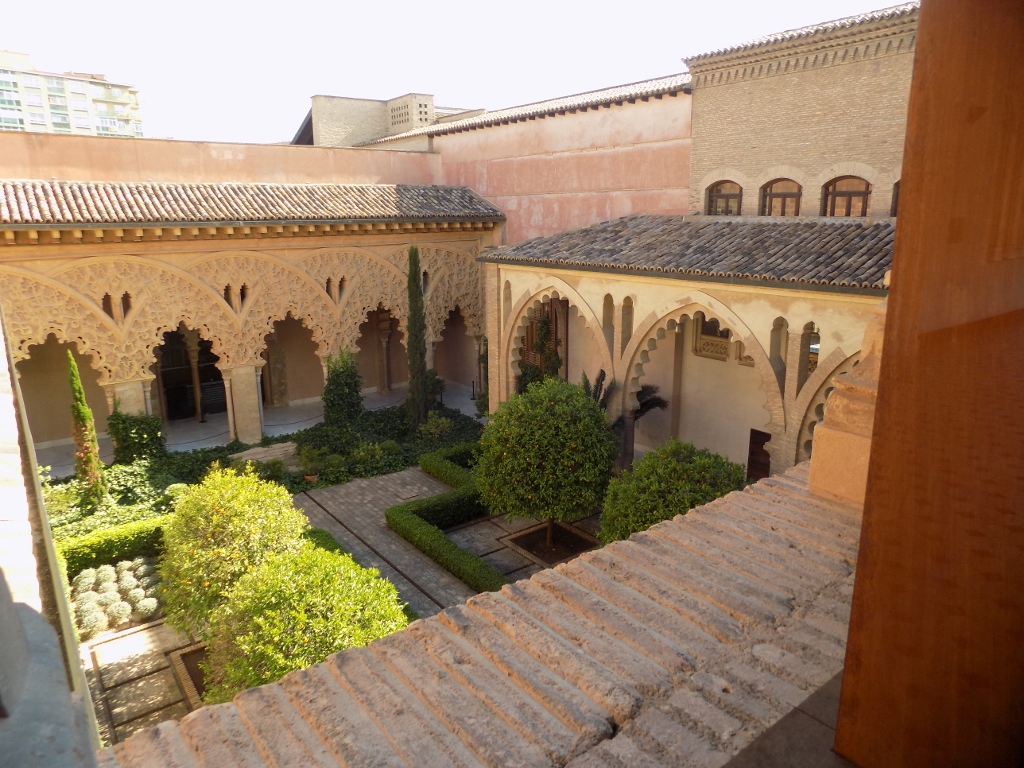 A detail from Aljafería
A detail from Aljafería
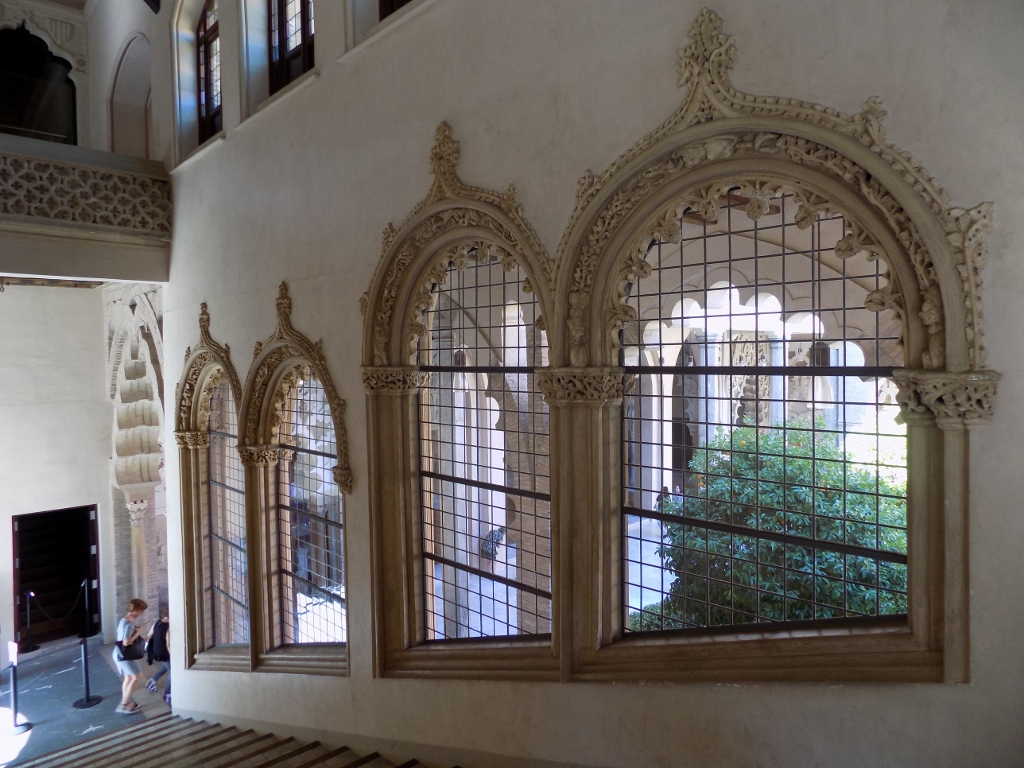 A detail from Aljafería
A detail from Aljafería
Towards the end of my visit I suddenly felt very weak. That was not pleasant. Especially when you are travelling and especially when this is happening already on the first day of a very specific and long journey. I consoled myself that this was all on account of the major sleep deprivation. Once I had finished with the visit, I went to a nearby square where there was a bar with a nice garden and sat there, putting my feet up on another chair and resting a little. I knew I could not really fall asleep at 6 pm, plus I had to eat something, so slightly refreshed I managed to get to El Tubo, a part of the city which constitutes the centre of the night life and entertainment. At almost 7 pm few places were open, but I did find one and had a nice dinner there. Soon I went back to my hotel room and not much later I went to sleep.
During the night, my brain got some rest from the lack of sleep so it started to be more active. Enough for me to remember a dream: I dreamt that I had decided to give up on my travel into space in some capsule. I was supposed to fly by that capsule and to come back, and it was all organised by a friend. The technical support was in hands of a group of audio technicians with whom I cooperate from time to time. In other words, one layman next to the other! When I suddenly woke up, I was not delighted. I also knew where these thoughts came from. Namely, I was seriously worried because of the weight of my backpack.
Although I was sure I had taken only the bare minimum of things, planning to wash it all during the pilgrimage in order to have clean clothes on me, instead of the targeted 11 kg in total, all of my things (the big and the small backpacks) had a total of almost 20 kilos!!! As I was waiting in line at the railway station in Barcelona I saw two young men for whom it was clear by the emblems they had on them that they were going on the Way of St. James, but their backpacks combined were not as large as my big one alone! I don’t know how people manage to travel so lightly. No matter how often I travel, I always have a lot of luggage. Admittedly, I do like to travel comfortably according to my standards. That does not mean a lot of clothes. No, I have given up on that long ago. But, let me give an example. Years ago, I used to be instructed by traditional hikers, which meant that I had a fleece jacket, as well as a water/wind-proof one, although I was travelling during summer. I also carried a small toiletry bag full of pharmaceutical products. Then I had a small sewing kit. A hat and two head-scarves. … But, although none of these things was individually heavy, all together it amounted to almost 14 kg (the big backpack alone).
So, in my two minds, between the unpleasant dream – I decided to give up which is not in my nature at all – and the realistic worry about how I was to carry the weight, I comforted myself that the weight had not slowed me down in Barcelona at all, although I was extremely tired then. I also started thinking about sending any possible “surplus” by Poste Restante to wait for me at some post office a few days later and then forward it on again. I had never used this general postal service, but I said to myself it was worth asking around. I also started to remember myself when I used to go hiking. Even then I carried a lot of things – an entire big backpack for a weekend’s trip. But I kept going back to the image of me “dancing” with the backpack on through the field of narcissus anemones (see: https://www.svudapodji.com/en/montenegro-2/). The image was immediately covered by the voice of a friend of mine telling me: “But you are no longer that young!” Still, in the end I also remembered a very dear hiking friend who, when I told him I worried about not being sufficiently fit, said to me:
- “Do you know how you become fit?”
- “???”
- “By making the first step.”
In other words, the beginning of the day was made heavy by the worry, fear and uncertainty. But, as one of sayings tells us it's too late to call back yesterday.
After the leisurely awakening, I got out where I faced a very strong and rather chilly wind. Since I had clothes for all seasons (there, it was good after all that I brought all those things!), I was fine and went for a walk in order to see a few churches built in the mudejar style. These churches concretely are not in the UNESCO’s List, but they were very nice nonetheless.
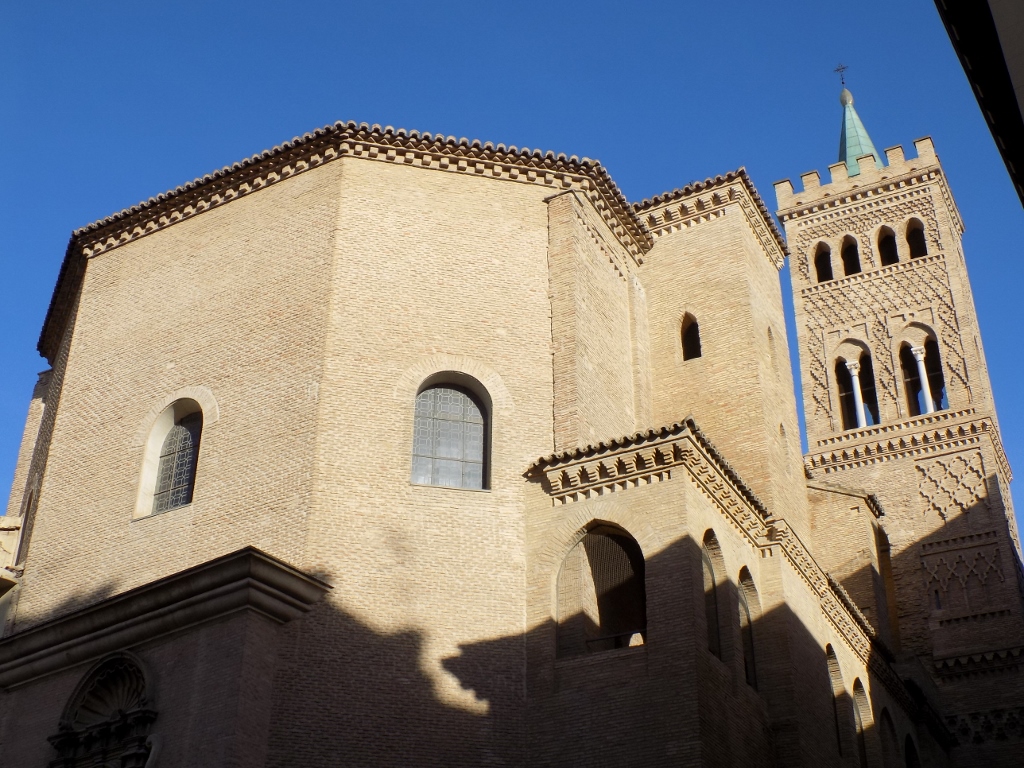 Church St. Gil Abad
Church St. Gil Abad
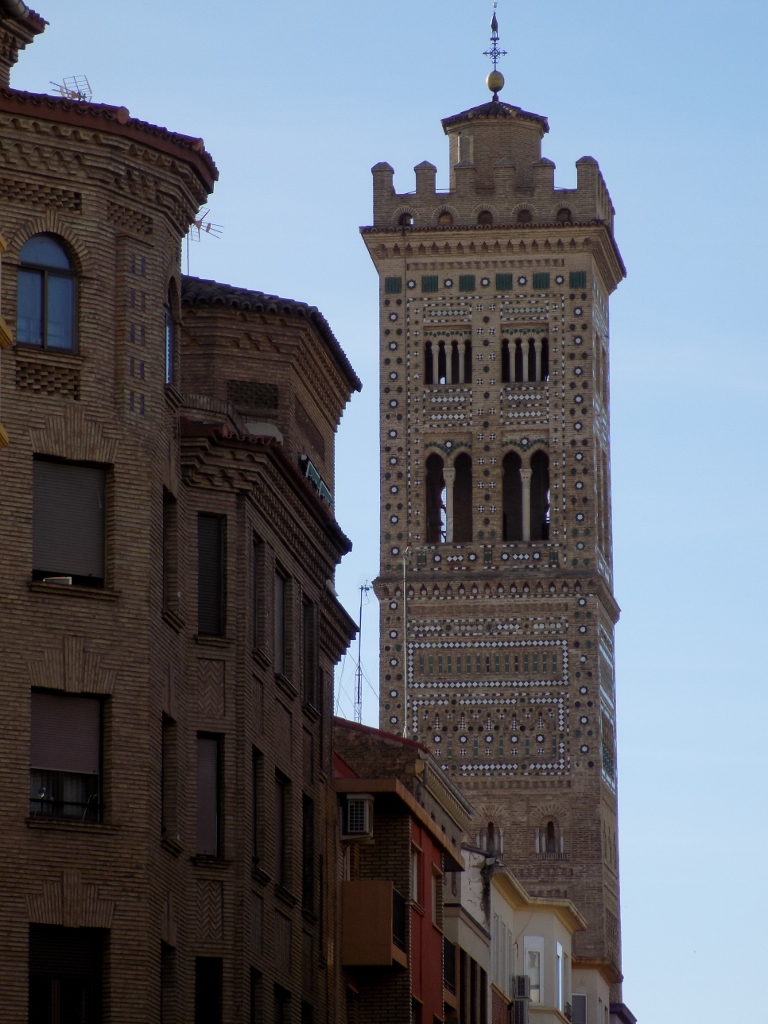 Santa Maria Magdalena church
Santa Maria Magdalena church
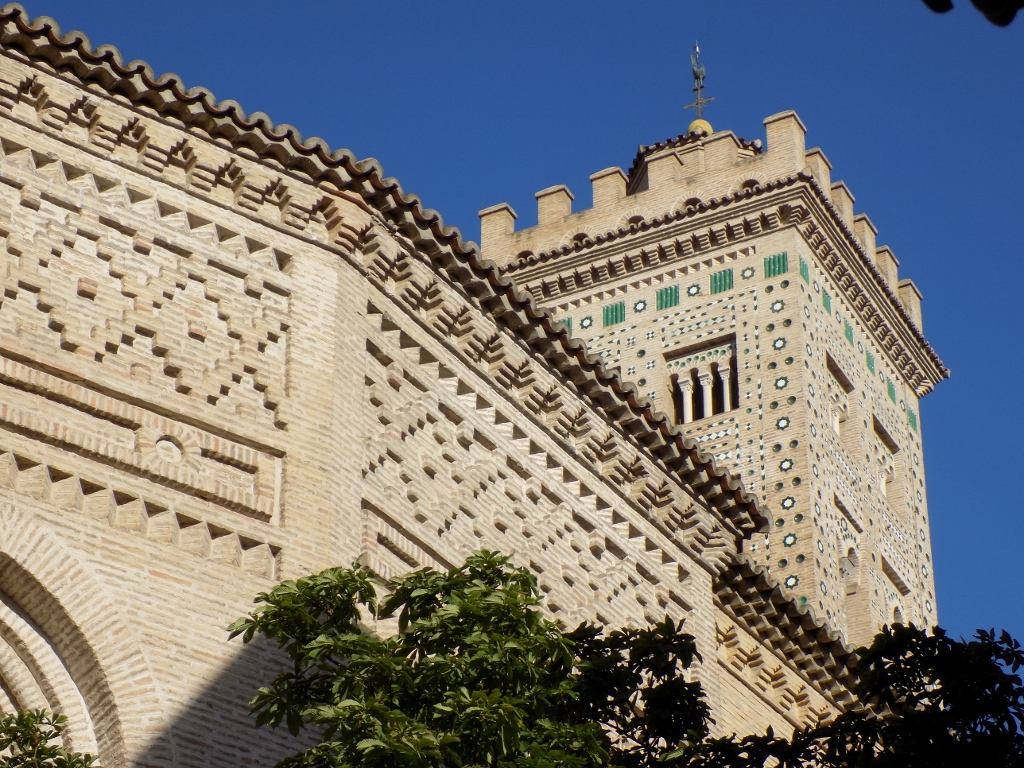 Santa Maria Magdalena church
Santa Maria Magdalena church
Still, my main destination was one bridge across the Ebro river. From there, there is a lovely view at the Stone Bridge and the Nuestra Señora del Pilar Basilica. I still felt heavy, burdened by all those thoughts, but here I decided to try to lift myself, so I started to sing a lively song “Od Ebra do Dunava” (From the Ebro to the Danube) that was entirely appropriate as I, as a woman living close to the Danube, watched from a bridge over the Ebro towards the centre of Zaragoza and felt the need to start myself and bring hope and joy into my existence. Listen to the song: https://www.youtube.com/watch?v=DKWijaOV3YY.
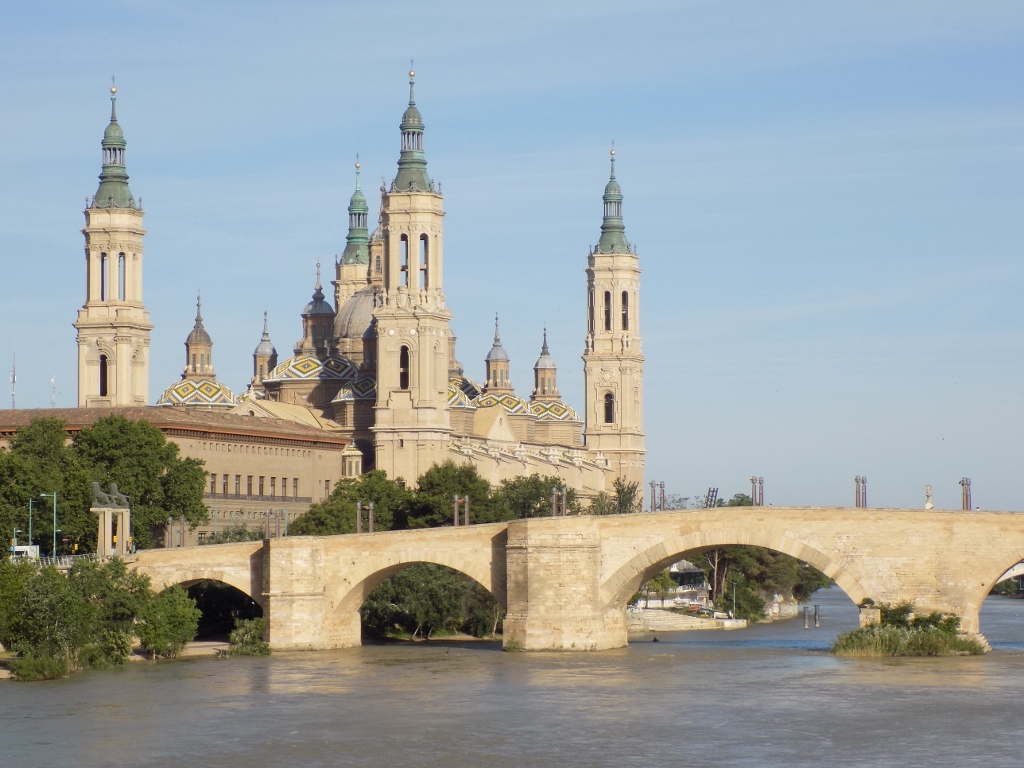 Stone Bridge and the Nuestra Señora del Pilar Basilica
Stone Bridge and the Nuestra Señora del Pilar Basilica
I walked a little along the other bank where it is possible to go down to the river itself. Although the sight was essentially the same, I could play a little bit with the photo-taking.
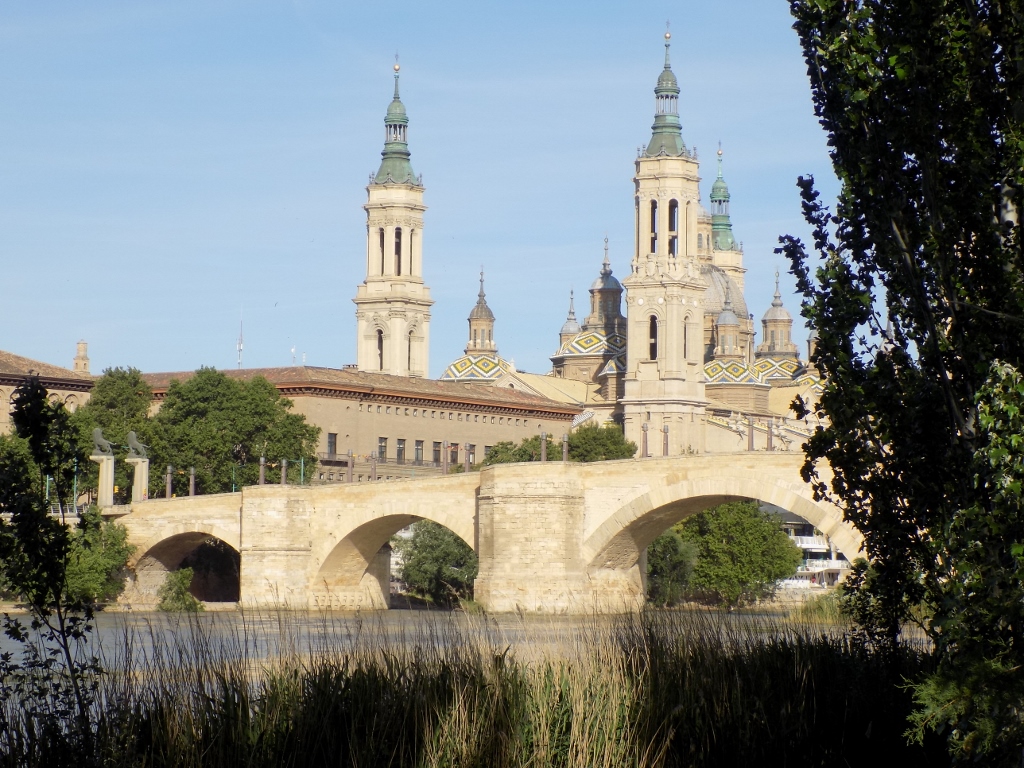 Stone Bridge and the Nuestra Señora del Pilar Basilica
Stone Bridge and the Nuestra Señora del Pilar Basilica
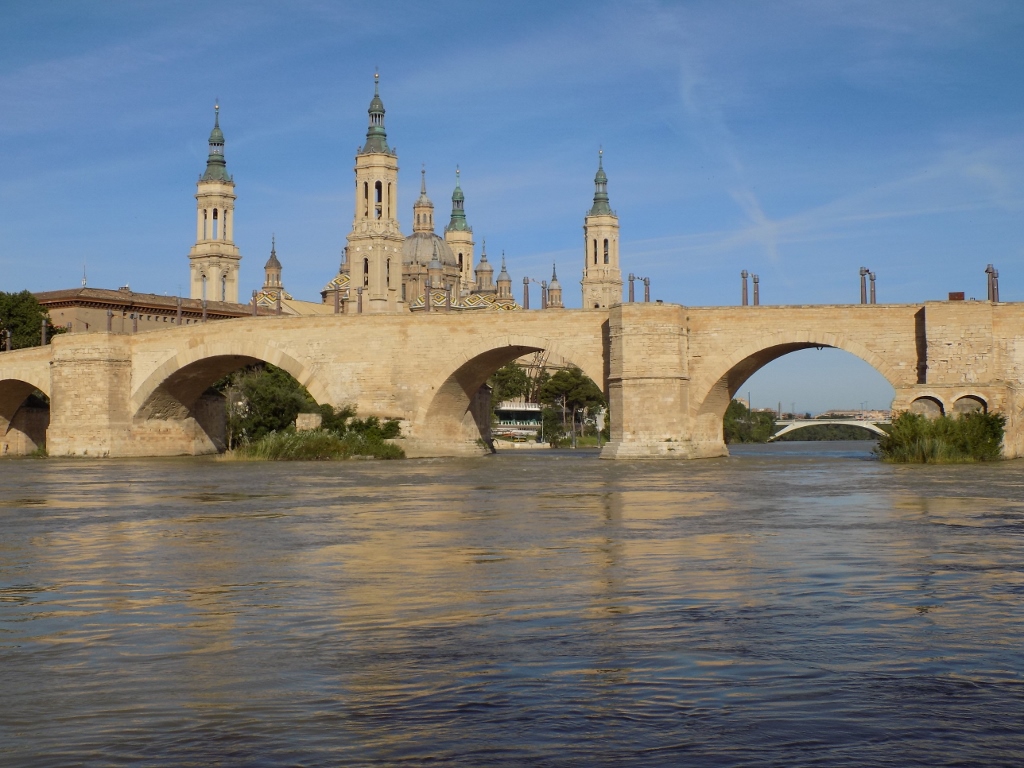 The Ebro, the Stone Bridge and the Nuestra Señora del Pilar Basilica
The Ebro, the Stone Bridge and the Nuestra Señora del Pilar Basilica
And then I went back to the Nuestra Señora del Pilar Square where I had a coffee and breakfast, writing a little in my travel journal and waiting for the end of the mass at the Cathedral La Seo in order to visit it. However, the mass lasted for quite a while and I was not in a mood to wait for too long. After all, I saw myself only as passing through Zaragoza, so I thought I needn’t be a proper tourist and see it all. Finally, I could leave something for the next time I come to visit Zaragoza.
Close to the hotel I had stayed at I had another coffee and soon I packed up and took a public bus in order to get to the coach station. I had already bought a ticket to Jaca through the internet, so all I had to do was wait for the inter-city coach.